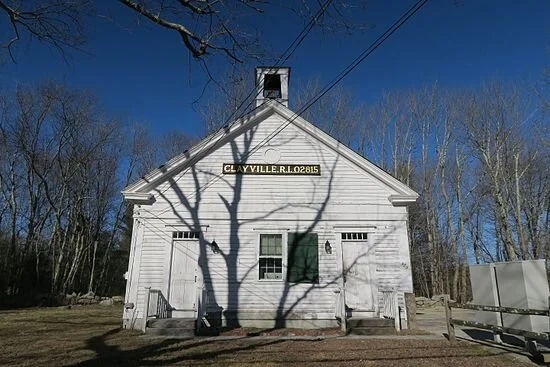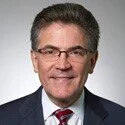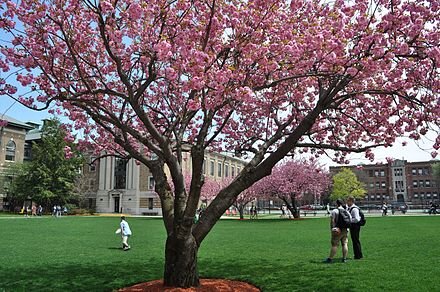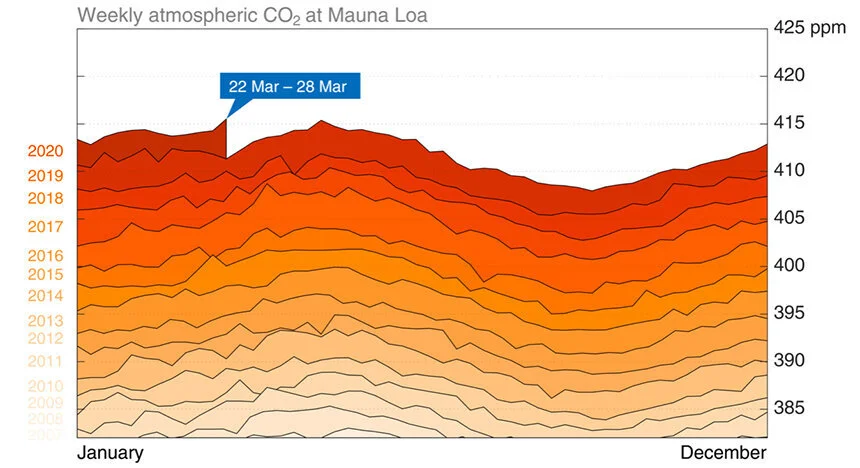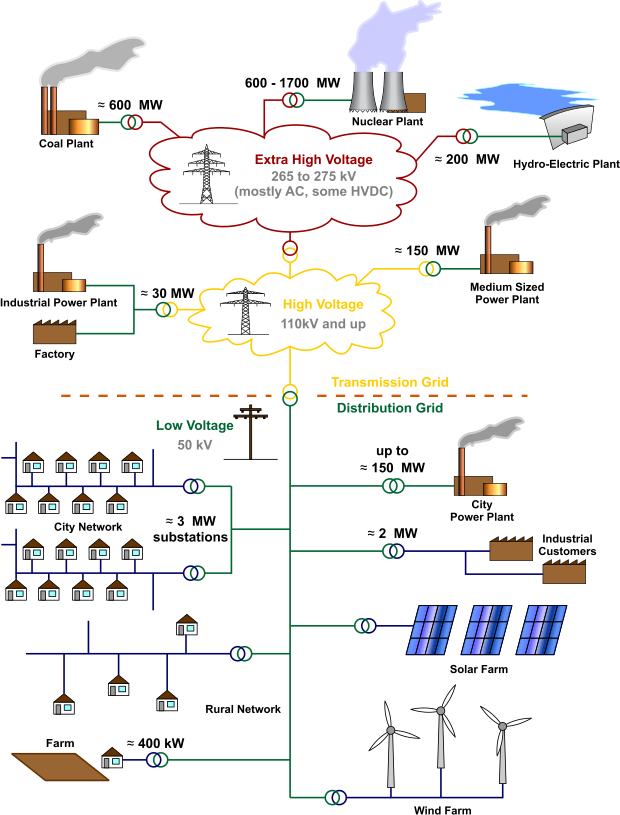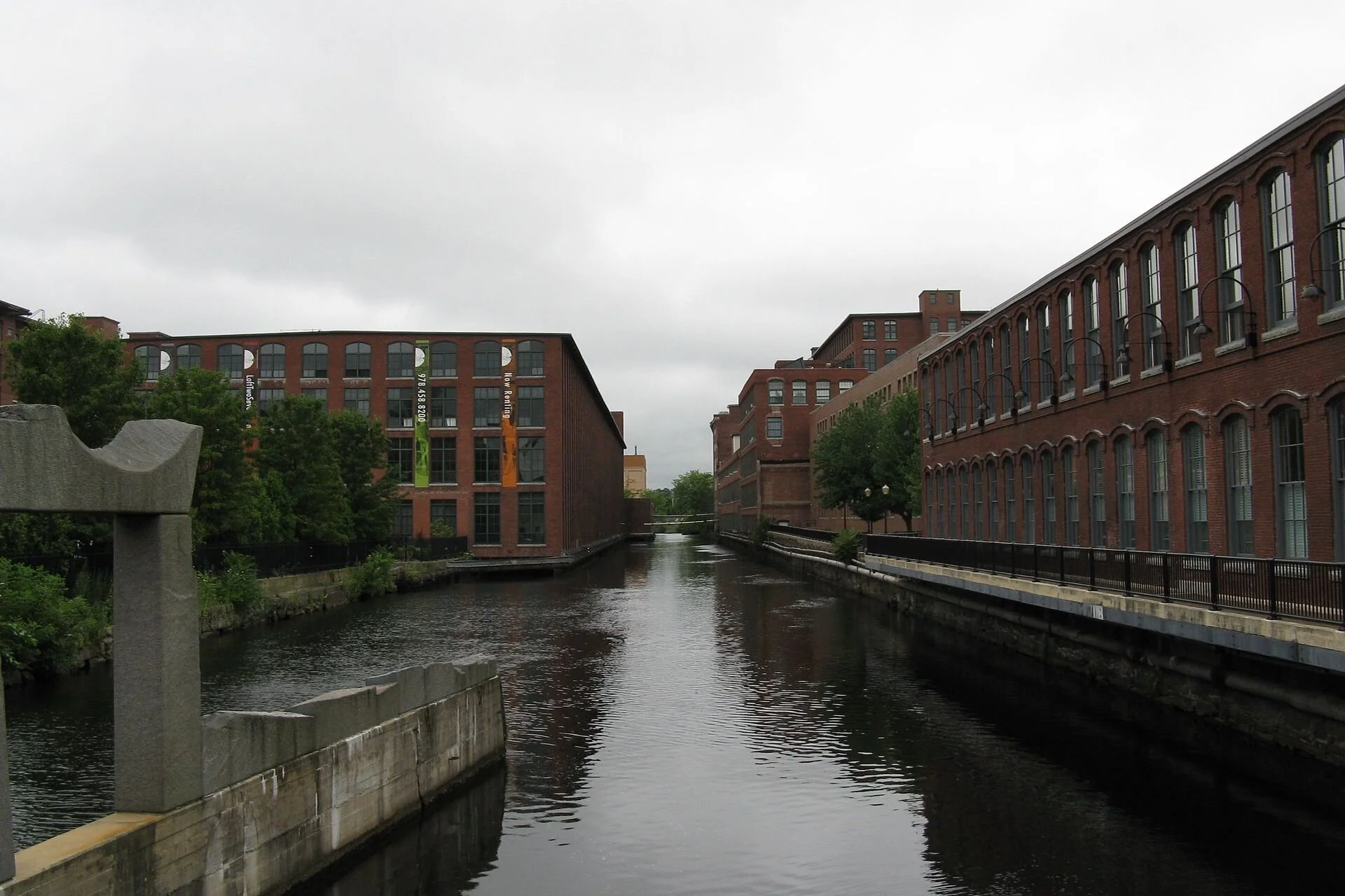
Thought for the Day
An April Fools' Day prank in Boston's Public Garden in 2011 warning people not to photograph sculptures. It refers to Make Way for Ducklings, the 1941 children’s book written and illustrated by Robert McCloskey. It’s the story of a pair of mallards who decide to raise their family on an island in the lagoon in the park.
Eating sprees improve your health.
Shopping sprees increase your wealth.
Drinking sprees enhance your cool.
Lovely news, but — April fool!
— Felicia Nimue Ackerman
A ticket to "Washing the Lions" at the Tower of London. No such event ever took place.
Live off the land?
The Clayville, R.I. Post Office
From Robert Whitcomb’s Digital Diary, in GoLocal24.com
The last few days have seemed abnormally cold, and they certainly have been mostly gloomy.
But in fact temperatures have generally been at, or even a little above normal for most of the past few weeks. We’d been spoiled by the extraordinarily warm winter, and thus find the normally hesitant New England spring more depressing than usual. Well, yes, there’s the other thing, too…
The current emergency may be making far more people aware of early-spring Nature because far more are walking around outside to battle claustrophobia and to get exercise, partly because most gyms have been closed. But it’s not a very social experience, as, for example, people tend to keep on the other side of the street from fellow walkers. Still, at least they’re looking at the flowers and trees more than they might have in a “normal spring.’’
I’ve been thinking that this would be a good time to head up to New Hampshire and Vermont, get a room at a Motel 6 and check out maple-syrup-making operations for a few days. Yeah, COVID-19 will be circulating up there too but the scenery is therapeutic.
An old friend of ours who lives in Florida part of the year has several dozen acres of field and woods in the Clayville section of Scituate, R.I. She only half-jokingly suggested that she’d move full time back to Clayville and “live off the land,’’ as people there (mostly) did 250 years ago. It wasn’t that long ago, historically speaking, that many of our ancestors lived on farms. My maternal grandfather’s family had a couple of farms in Upstate New York, and even some of my New England ancestors in the great-grandparent generation had working farms in Massachusetts. Those who didn’t might have had a couple of cows and some chickens.
Dead or alive, we're in this together
“Circle Round “ (encaustic, acrylic, cardboard, paper, wood panel, rusty bicycle wheel), by Sue Katz, an artist living in the Pioneer Valley area of western Massachusetts. Her Web site is suekatzart.com. She is a member of newenglandwax.com
The Pioneer Valley (part of the Connecticut River Valley) from space, with Springfield toward the bottom of the photo and Northampton-Amherst toward the top.
The front entrance to The Bookmill, in Montague, Mass., in the Pioneer Valley
David Warsh: 'How do economic crises end?' and other mega-questions
Wall Street on May 14, 1884 during a panic
— From Harper’s Weekly
SOMERVILLE, Mass.
Economists are occasionally accused of physics envy, because some of the mathematical language they use to describe, say, the interdependence of supply and demand was originally devised to explain equilibrium in celestial mechanics.
In the current crisis, economists may be suffering from physician envy. Every day brings reassuring new evidence of the depth of knowledge that life scientists, public health experts and medical doctors are bringing to bear on the COVID-19 pandemic.
Economists have ample reason to be proud of themselves. I can’t prove it, but I can demonstrate to anyone willing to learn, thanks to a regular series of short analytic memoranda published by a non-partisan Web site with the slightly in-your-face name of EconoFact.
EconoFact, published by the Edward R. Murrow Center of the Fletcher School of Tufts University, was founded in January 2017 by Michael Klein, of Tufts, and various colleagues. A former chief economist in the Office of International Affairs of the U.S. Treasury Department, Klein was accustomed to writing policy briefs laying out options for decision-makers, So were many of his friends.
Dissatisfied with what they regarded as overmuch weight being given to fringe views by news accounts and op-ed pages striving for balance, they aimed to convey to key journalists and others affecting policy in Washington and state capitals the scope of differences among mainstream views. Contributors, many of them with government experience, have since grown to a network of nearly a hundred economics professors.
Unlike the National Bureau of Economic Research, the leading U.S. consortium of research professors, the charter of which specifically forbids advocacy in its sponsored research, EconFact authors begin with the premise that action is required and then briefly lay out possibilities. Project Syndicate, an online op-ed page promoting the work of some 75 leading economists, makes interesting reading; so does Vox-EU, edited by Richard Baldwin, of Geneva’s Graduate Institute, and published by the Centre for Economic Policy Research, the European counterpart of the NBER.
Compared to these, EconoFact has a much tighter focus. Its headings include
Immigration Policy, Federal Budget Deficit, Jobs and Employment, and Coronavirus. Nine briefs on the COVID-19 crisis have been published in the last two weeks, each around 1,300 words. You can read them individually below, or scan them serially here.
When will the US be able to lift social distancing restrictions and begin to restore its economy? by Hoyt Bleakley, University of Michigan (March 26)
How many workers are likely to need cash income assistance during this economic slowdown? by Melissa Kearney and Luke Pardue, University of Maryland (March 26)
What do interpretations of the Great Depression and the Financial Crisis of 2008 suggest about how the current crisis might end?, by Dan Sichel·
Wellesley College (March 23)
How much additional funding and what modifications to the system of unemployment might be required in the current crisis?, by Patricia M. Anderson and Phillip Levine, Dartmouth College and Wellesley College (March 22)
What is the appropriate infrastructure to disburse cash payments rapidly and fairly, given that those most desperately in need are often the hardest to reach?, by Lisa A. Gennetian, Sanford School of Public Policy, Duke University (March 20)
How to rate speed as a factor in an economic policy response? by Megan Greene and Michael Klein, Harvard Kennedy School Fletcher School, Tufts University (March 17)
What lessons can be drawn from experience of the 1918 influenza pandemic? by Phillip Levine and Robin McKnight·Wellesley College (March 17)
What is the Federal Reserve doing to stabilize market affected by closures and quarantines? by Kenneth Kuttner, Williams College (May 15)
My favorite of these is “How Do Economic Crises End?” because of its obvious sophistication. Sichel, its author, retired from the Fed in 2012, having been part of its senior analytic team in the years before and after the 2008 crisis. The comparison he makes between the unaddressed banking panics that ushered in the Great Depression and the quickly confronted Panic of 2008 has not yet become a standard feature of Coronavirus crisis discussion.
It opens the door for more careful attention to resemblances and dissimilarities of current shutdowns to the events of 1929-1933 and their aftermath. And it identifies common denominators in the ends of both major crises: “two ingredients are needed to stanch the acute phase of an economic crisis,” it states: “a resolution of the underlying cause and a dramatic economic policy response that mitigates the economic damage and causes a shift in sentiment.”
About that slightly pugnacious name: It may be just me, but at a time when claims to deliver “truth” are being bandied about in marketing campaigns as if it were something easy to know, even a claim to having assembled the relevant facts seems a little immodest.
Executive editor Klein demurs: “We back up everything we publish with lots of hyperlinks to sources; so maybe EconoFact is not so much in-your-face as accurate, perhaps even revelatory, that is “revealing something hitherto unknown.” The work we publish is probably not news to trained economists, but may be so to the public who are regularly fed a diet of “Experts disagree about ...” (fill in the blank) when, in fact, there is often broad consensus among economists.
“Too often news media treat economic matters like a sports event with a lonely and unsupported economist on one side and someone else (who represents the consensus view of economists who have spent their professional careers studying these issues) on the other.”
EconoFact is looking for long-term funding. It wouldn’t cost a fortune to keep a couple of editors and an intern employed. Here’s hoping those deep pockets can be found. The name, no doubt, is here to stay. Long may the enterprise continue to ask and answer pointed questions.
David Warsh, an economic historian and veteran columnist, is proprietor of economic principals.com, where this essay originated.
N.E. Council update on COVID-19-related activities
“Brother Jonathan’’ was a 19th Century personification of New England.
BOSTON
COVID-19 briefing from The New England Council (newenglandcouncil.com)
“As our region and our nation continue to grapple with the Coronavirus Disease (COVID-19) pandemic, The New England Council is using our blog as a platform to highlight some of the incredible work our members have undertaken to respond to the outbreak. Each day, we’ll post a round-up of updates on some of the initiatives underway among Council members throughout the region. We are also sharing these updates via our social media, and encourage our members to share with us any information on their efforts so that we can be sure to include them in these daily round-ups.
You can also check our COVID-19 Virtual Events Calendar for information on upcoming COVID-19 related programming – including Congressional town halls and webinars presented by NEC members.
Here is the March 30 roundup:
Medical Response
Novartis Anti-Malaria Drug Gets Emergency Approval from FDA – Following emergency approval from the Food and Drug Administration (FDA) of two anti-malaria drugs for the potential treatment of COVID-19, Novartis, along with Bayer, is contributing millions of doses of the drugs, hydroxychloroquine and chloroquine. The drugs have previously received much attention following some anecdotal evidence to support the benefits to relieve respiratory symptoms of infected patients, and could be a potential treatment to reduce symptoms and strain on healthcare providers. The Washington Post has more.
Sanofi Expands Clinical Trial – After announcing the beginnings of its clinical trials in the United States last week, Sanofi—along with Regeneron Pharmaceuticals—has expanded the trial in Italy, Spain, Germany, France, Canada, and Russia. The trials will test the rheumatoid arthritis drug Kevzara as a potential treatment for patients around the world. Read more in CNBC.
Economic/Business Continuity Response
New Balance Shifts to Producing Masks – At its Lawrence, Mass., manufacturing facility, New Balance has begun producing prototypes for face masks to distribute around the region and country. As hospitals and those exposed to the virus begin to see shortages of protective gear such as face masks, New Balance has joined other local manufacturers in an “all hands on deck” response to the need. Read more in WCVB Boston.
Harvard University Guarantees Pay for All Workers Through End of Semester – To ensure that those who are willing and able to work are paid, Harvard University updated its policies to include payment and benefits for all workers through May 28. The updated policy includes those employed in dining, security, and custodial services across the university, as well as those in administrative and contract roles. Harvard is also providing stabilization funds to the six independent childcare centers on campus to allow the employees to work. The Boston Business Journal
Community Response
Suffolk University, Pine Street Inn to Repurpose University Residence Hall to House Homeless Population – In light of its switch to remote learning, Suffolk University has offered a residence hall to the homeless population of Boston. The residence hall will provide 172 beds, and will be managed by both Pine Street Inn and the city’s Public Health Commission to reduce congestion and increase social distancing in shelters. The Boston Business Journal has more.
AARP Launches Platform to Connect Volunteers with Those in Need – AARP announced its new online platform, AARP Community Connections, to organize and mobilize volunteer groups and connect them with people and families who need assistance. From groceries to financial assistance to emotional support, users of the platform can receive a wide variety of support in the age of social distancing. Read more in KTVZ.
Amgen Donates $12.5 Million to Relief Efforts – Amgen has committed $12.5 million to support the efforts of local emergency and patient-focused services. In addition to the funds, Amgen is supporting online learning platforms to provide resources to students as they transition to remote instruction. Read more.
Tufts Health Plan Announces $500,000 for Food-Insecure Elderly People – Tufts Health Plan has committed the first half of its $1 million donation in relief efforts to combat food insecurity among in the New England region. Tufts has identified 21 organizations that provide meals and other support to individuals we well as food banks and other businesses coordinating a regional response as the recipients of the first wave of funding. Read more in the Portsmouth Press.
Stay tuned for more updates each day, and follow us on Twitter for more frequent updates on how Council members are contributing to the response to this global health crisis.’’
Now comes babbling April
Stream in Southbury, Conn.
— Photo by Karlfonza
To what purpose, April, do you return again?
Beauty is not enough.
You can no longer quiet me with the redness
Of little leaves opening stickily.
I know what I know.
The sun is hot on my neck as I observe
The spikes of crocus.
The smell of the earth is good.
It is apparent that there is no death.
But what does that signify?
Not only under ground are the brains of men
Eaten by maggots.
Life in itself
Is nothing,
An empty cup, a flight of uncarpeted stairs.
It is not enough that yearly, down this hill,
April
Comes like an idiot, babbling and strewing flowers.
— “Spring,’’ by Edna St. Vincent Millay (1893-1950), a Maine native
Solar panels best on roofs and abandoned parking lots
From Robert Whitcomb’s “Digital Diary,’’ in GoLocal24.com
I hope that solar-energy firms in New England are constantly on the lookout for already open land, such as parking lots around moribund shopping centers, as alternatives to cutting down woodlands to make space for solar panels. The recession we’re now in may well make more moribund shopping center parking lots available.
Trees, after all, are also important in addressing climate change, not to mention wildlife and green aesthetics that help humans’ health. There’s a natural temptation to use a lot of that woodland in, for example, exurban southern and western Rhode Island for solar farms. But there’s plenty of asphalt open space in our urban areas, and wide flat roofs on big-box stores.
Martha Bebinger: COVID-19 taking an axe to Mass. health-care workers' pay
BOSTON
Just three weeks ago, Dr. Kathryn Davis worried about the coronavirus, but not about how it might affect her group of five OB-GYNs who practice at a suburban hospital outside Boston.
“In medicine we think we’re relatively immune from the economy,” Davis said. “People are always going to get sick; people are always going to need doctors.”
Then, two weeks ago, she watched her practice revenue drop 50 percent almost overnight after Massachusetts officials told doctors and hospitals to stop performing elective tests and procedures. For Davis, that meant no more non-urgent gynecological visits and screenings.
Late last week, as Davis and her partners absorbed the stunning turn of events, they devised a stopgap plan. The 35 nurses, medical assistants and secretaries they employ would have two options: move from full-time to part-time status or start collecting unemployment. Doctors in the practice would take a substantial pay cut. Davis said she’s hearing from colleagues who may have to permanently close their offices if the focus on crisis-level care continues for months.
“It’s shocking,” she said. “Everyone has been blindsided.”
Atrius Health, the largest independent physician group in Massachusetts, said patient volume is down 75 percent since mid-March. It is temporarily closing offices, placing many nonclinical employees on furlough and withholding pay for those who remain. The average withholding is 20 percent and the company pledges that pay withheld will be returned. The lowest-paid workers, those earning up to $55,000, are exempt.
Steven Stongwater
“What we’re trying to do is piece together a solution to get through the crisis and keep employed as many people as we can,” said Dr. Steven Strongwater, Atrius Health’s CEO.
Atrius cares for 745,000 patients in clinics that often include primary care, specialists, radiology and a pharmacy under one roof.
Strongwater said physician groups must be included when the federal government distributes $100 billion to hospitals from the $2 trillion stimulus package.
It’s not clear if that money will stop the tide of layoffs and lost pay at hospitals as well as in doctor’s offices. A Harvard Medical School physician group will suspend retirement contributions starting April 1.
Part of Beth Israel Lahey Health.
Beth Israel Lahey Health, the second-largest hospital network in Massachusetts, announced executive pay cuts Monday.
“The suspension of elective procedures and decline in visits to our primary-care practices and urgent care centers have resulted in financial challenges,” wrote CEO Dr. Kevin Tabb in an email to employees. Tabb said he would take a 50% salary cut. Other executives and hospital presidents in the system will forgo 20% of their salaries for the next three months.
“Although executive leadership compensation is being reduced, we will never compromise on doing the things that are essential to protect your safety and the safety of our patients,” Tabb told staff.
Dallas-based Steward Health Care has told hospital employees in Massachusetts and eight other states where it operates to expect furloughs focused on nonclinical staff. In a statement, Steward Health Care said it prepared for the pandemic but is experiencing a “seismic financial shock.”
“Elective surgeries are the cornerstone of our hospital system’s operating model — and the negative impact due to the cancellations of these procedures cannot be overstated. In addition, patients are understandably cautious and choosing to defer any nonemergency treatments or routine visits until this crisis has passed.”
Dr. Kaarkuzhali Babu Krishnamurthy, an assistant professor of neurology at Harvard Medical School who studies medical ethics, said employers need to think more carefully about the ethics of asking doctors and nurses to live on less when many are working longer hours and putting the health of their families at risk.
“At a time when health-care systems are calling on doctors and nurses to do more, this is not the time to be making it more difficult to do that,” said Krishnamurthy.
There’s talk of redeploying laid-off health care workers to new COVID-19 units opening in shuttered hospitals or to patient overflow sites. Tim Foley, executive vice president for the largest health care union in Massachusetts, 1199SEIU, is promoting the development of a staff registry.
“It is more important, now more than ever, to explore all options to maintain the level of urgent care needed across the state and we look forward to working with all stakeholders to do just that,” Foley said in an email.
This story is part of a partnership that includes WBUR, NPR and Kaiser Health News.
Martha Bebinger is a reporter for WBUR, in Boston.
Martha Bebinger, WBUR: marthab@wbur.org, @mbebinger
Cynthia E. McGrath: Squeezed N.E. colleges seek ways to save on employee health benefits
On Wentworth Institute of Technology’s quad, in Boston
Via The New England Journal of Higher Education, a service of The New England Board of Higher Education (nebhe.org)
BOSTON
The COVID-19 pandemic is top of mind for everyone. There’s no aspect of our lives that’s been untouched. For colleges and universities, the novel coronavirus crisis has caused a major educational shift. Campuses are closed to students. Courses have moved online. And many graduation ceremonies will be canceled or postponed. How long the new norm continues is unknown, but there is bound to be an effect on higher education budgets.
Before COVID-19 entered our lives, colleges and universities were already facing enormous pressures on their bottom lines. Sixty percent of higher education institutions (HEIs) missed their fall 2019 enrollment goals, according to a recent Chronicle of Higher Education story. Changing demographics and drops in international enrollments are primary reasons. Moreover, the Great Recession of 2008-2013 caused a significant drop in the U.S. birthrate, leading to projected enrollment declines for the foreseeable future.
To close the budget gap, many HEIs are developing student recruitment pipelines. However, colleges and universities should also look for cost-curbing strategies. Compensation and benefits comprise as much as two-thirds of an HEI’s budget, and taking a hard look at health insurance costs for faculty, staff and family members is a winning tactic. “Demographic changes and travel restrictions are affecting the revenue side of a school’s ledger, so it’s important for colleges and universities to not only find solutions that maximize revenues, but also look at containing expenses,” said William Hall, vice president for administration and chief financial officer at Salve Regina University, in Newport, R.I.
“The number of 18-year-old students is going down, and colleges and universities need to look at all of their expenses to offset lower revenues, if applicable,” said Margaret Card, Wentworth Institute of Technology’s (in Boston) human-resources director. “Frequently there are economies-of-scale opportunities, such as for training, temporary agencies, joint contracts and healthcare purchasing that are worth pursuing so that the savings can be invested in scholarships and other priorities.”
In late 2006, the Boston Consortium, which brings together Boston-area colleges and universities to develop and implement cost-saving and quality-improvement ideas, gathered a group of chief financial and chief HR officers to find out how to slow health insurance cost increases. Fast forward to 2013, and the results of those efforts, in collaboration with other college and university groups, was the formation of edHEALTH, a healthcare purchasing consortium of HEIs.
“The rising costs of our employee healthcare benefits were putting a strain on the operating budget of Boston College. We were determined to find a solution to the healthcare cost conundrum,” said John Burke, financial vice president and treasurer at the college. “Our objectives were to preserve our plan design, which varies by educational institution, and realize cost savings in our healthcare benefit budget. The ultimate solution we landed on with edHEALTH achieved both objectives.”
How the funding works
The self-insurance arrangement of edHEALTH means member HEIs aren’t paying profits on top of claims. If a college’s healthcare utilization is lower than budgeted, the excess funds remain in the individual school’s account instead of staying with the carrier. However, going from an insured to a self-insured arrangement can be daunting, particularly for small institutions.
“Most colleges and universities that are considering edHEALTH have an employee population of at least 200,” said edHEALTH President A. Tracy Hassett. “A self-insured arrangement can be risky for a small school that doesn’t have the resources to weather a high-claims cost year.” Under the edHEALTH captive arrangement, member schools pick their own self-insured retention level based on their risk tolerance, philosophy, financial status and experience. They can further protect their risk by purchasing aggregate stop-loss coverage in addition to the coverage they automatically receive.
“Our school already had a self-insured arrangement when we joined edHEALTH, so that wasn’t a barrier,” said Wentworth’s Card. “By working together with other schools, we could leverage the group buying power to decrease our administrative and re-insurance costs, which was a win-win.”
edHEALTH recently entered into a prescription drug carve-out arrangement with a larger consortium of colleges and universities that has led to additional savings. All member HEIs now receive 100% of the pharmacy rebates. In the first year, every member HEI saved 18% of its pharmacy expenses because of this initiative. “We’re always looking for innovative ways to provide high-quality benefits while reducing costs,” said Hassett.
edHEALTH can help with attracting and retaining talent
Many HEIs that have joined edHEALTH have passed along some of the savings to their employees, which has helped with hiring and retaining employees. Olin College of Engineering, for example, offered its employees a month of free healthcare premiums in December 2016. Wentworth and Salve Regina have each offered a month of free premiums twice. Wentworth also reduced the percentage of premium that employees pay.
Dean College, which recently joined edHEALTH, was looking for a competitive edge when it decided to improve its employee health benefits and join edHEALTH. The move halved employees’ out-of-pocket deductible. “Offering robust healthcare benefits enables us to attract and retain quality employees,” said Daniel Modelane, vice president of financial services and treasurer at Dean. “The previous deductible was a lot of exposure for our employees, and we were able to cut it in half, which is a helpful recruiting tool.”
Collaboration is an added bonus
Saving money isn’t the only reason HEIs join edHEALTH. Collaboration and transparency with peers combined with data insights are integral benefits.
Member owners share and learn from one another. Representatives from each member institution (typically benefits administrators) meet monthly to determine plan year design options. The Plan Design Committee’s collaboration with the third-party administrators (TPAs) and consultants helps to ensure the optimal suite of choices. “Moving to edHEALTH is a long-term healthcare strategy,” said Sean Carney, partner at 360 Corporate Benefit Advisors, Dean College’s benefits consultant. “This group of edHEALTH schools provides a sense of community and camaraderie for the betterment of the higher education industry.”
Getting a college or university’s finance and HR departments to work together to find healthcare solutions is sometimes a challenge. At Salve Regina, HR resides under the administration and finance umbrella, so this has not been an issue. However, that’s not always the organizational structure. “HR and finance have to partner together because finance looks at the money and HR looks at the quality of care,” said Card of Wentworth. “If both points of view are represented, you can make a better decision.”
In 2019, edHEALTH entered into an agreement with a national administrator so it could offer access throughout the country. Sarah Lawrence College became the first New York school to join. The recently expanded edHEALTH website and the launch of other communication vehicles improve member and business partner engagement. New population health initiatives help improve care coordination and reduce costs for high-risk, high-cost employees and family members. And data mining tools help members realign strategies to drive behavior.
“Higher education is competing for students, faculty and staff,” said edHEALTH’s Hassett. “edHEALTH has consistently beat the rising healthcare cost curve with an average 3.5% premium increase over the last five years compared with the industry average of 8.1%. That’s money that schools can invest in their core business of educating students.”
“Sixty percent of our budget is compensation and benefits, and the edHEALTH solution has improved our cash flow, given us access to affordable stop-loss coverage, reduced administrative plan costs and enabled us to offer our employees premium holidays (no payroll deduction) on two occasions,” said Hall of Salve Regina. “Since joining in 2016, our budget savings have exceeded $2.5 million on an annual healthcare budget of $4.3 million.”
Cynthia E. McGrath is a senior healthcare and HR marketing communications consultant. Email: cemcgrath@educatorshealth.org.
Tim Faulkner: COVID-19 shoves aside climate crisis
A year ago last week the concentration of atmospheric carbon dioxide was 411.24 parts per million. Last week’s reading had the CO2 concentration at 415.52.
— Center for International Climate Research)
From EcoRI News (ecori.org)
There’s not a lot to cheer about for the environment in the federal response to the COVID-19 crisis.
The $2-plus trillion economic stimulus signed on March 27 didn’t include a lifeline to the climate crisis or the renewable-energy industry, which according to wind and solar industry groups, is at risk of losing up to 155,000 jobs, or about half of the sector’s workforce. Rhode Island has about 16,000 jobs in its so-called “clean economy” industry.
Republicans in Congress fought renewable-energy and environmental stimulus by characterizing it as a political ploy.
“Democrats won’t let us fund hospitals or save small businesses unless they get to dust off the Green New Deal,” Senate Majority Leader Mitch McConnell said. The Kentucky Republican, though, pushed, unsuccessfully, the creation of a $500 billion business-relief program that would be controlled by the Department of the Treasury and have little oversight — although the Trump administration is now fighting that agreed-upon oversight.
A House plan was axed from the final stimulus package that would have required airlines to cut their emissions in exchange for $29 billion in aid.
Solar and wind trade organizations asked for, but didn’t receive, direct funds to help renewable-energy companies and their employees. Extensions of the Renewable Electricity Production Tax Credit and the Solar Investment Tax Credit weren’t granted. A request was also omitted from the massive aid plan that would have allowed a portion of the tax credits to be offered as direct payments to financial backers of renewable-energy projects, who, during a year with many expected losses, would have a greater interest in cash than tax credits.
Local solar installers are weathering the crisis as they report steady demand, while taking extra health precautions with customers. They are reporting a well-stocked supply chain and an increase in requests for home solar-battery storage systems.
The stimulus package provided no direct funding for the coal, oil, and gas industries, but pipeline and other fossil-fuel workers have been deemed essential and are staying on the job for infrastructure projects around the country, including the controversial natural-gas pipeline compressor station in Weymouth, Mass.
The coronavirus hasn’t curtailed a 30-day comment period for a controversial Environmental Protection Agency (EPA) proposal that limits the use of research in regulatory decisions. Basically, the Trump administration has fast-tracked a proposal to limit the use of human health science in environmental decision-making.
On March 26, the day before the stimulus package was approved, the EPA relaxed penalties against and enforcement of regulated polluters such as wastewater treatment facilities and generators of air pollution and hazardous waste.
Former EPA Director Gina McCarthy, now the president of the Natural Resources Defense Council, said, “This is an open license to pollute. Plain and simple. The administration should be giving its all toward making our country healthier right now. Instead, it is taking advantage of an unprecedented public health crisis to do favors for polluters that threaten public health.”
Prevention, reporting and clean up are still required under the EPA rule-easing for oil spills and the release of hazardous chemicals and waste. But violators can’t be punished if the violations are the result of COVID-19 restrictions.
Climate-justice areas, such as those near the industrial port along Providence’s waterfront, are expected to endure added health and safety risks from reduced regulatory compliance.
A silver lining, however, of the public-health crisis is the reduction in air pollution and fossil-fuel use. Home confinement has sharply curtailed vehicle traffic and air travel. Between 50,000 and 75,000 people may have been saved from dying prematurely thanks to improved air quality, according to Marshall Burke, an assistant professor at Stanford University’s Department of Earth System Science.
Images taken during the first three weeks of March show less nitrogen dioxide — created from fossil-fuel use by cars, trucks, buses, power plants, and off-road equipment — over parts of the United States than the same time last year, according to a recent CNN story.
Elsewhere in the media, climate experts are making connections between the climate crisis and COVID-19 pandemic, showing a range of hope and fear over the struggle between economic growth and producing less to mitigate climate change.
In an opinion published in The Boston Globe, Craig Altemose, executive director of the climate-activist group Better Future Project, argued that after the crisis subsides businesses should embrace telecommuting as a means of reducing emissions from the transportation sector, the largest source of greenhouse gases. He also suggested that consumers should scale back long-distance travel. He wrote that getting health-care aid to the most needy and developing countries would allow vulnerable populations to better manage the impacts of extreme heat and other climate impacts and would reduce the flow of climate refugees.
“There’s still much to learn from our response to the coronavirus,” Altemose wrote, “but we should aim to move forward on the other side of this pandemic with the right lessons rather than going back to flawed and failing systems.”
The public-health crisis and economic slowdown, however, hasn’t brought carbon emissions to a halt or reduced atmospheric concentrations, as the weekly atmospheric CO2 count at the Mauna Loa Observatory in Hawaii shows emissions at more than 415 parts per million.
“Any cuts in emissions as a result of the economic crisis triggered by COVID19 are not a substitute for concerted climate action,” according to the World Meteorological Organization.
A year ago last week the concentration of atmospheric carbon dioxide was 411.24 ppm. Last week’s reading had the CO2 concentration at 415.52. (Center for International Climate Research)
Tim Faulkner is an eco RI News journalist.
Gas-pipeline compressor facility like the one being built in Weymouth
'Full of Romance'
On the Franconia Range of the White Mountains
“It has often been said that the New World is deficient in the elements of poetry and romance ; that its bards must of necessity linger over the classic ruins of other lands; and draw their sketches of character from foreign sources, and paint Nature under the soft beauty of an Eastern sky. On the contrary, New England is full of Romance....we have mountains pillaring a sky as blue as that which bends over classic Olympus; streams as bright and beautiful as those of Greece and Italy, and forests richer and nobler than those which of old were haunted by Sylph and Dryad.”
― John Greenleaf Whittier (1807-92), Massachusetts poet
Gaze at the greening
From Robert Whitcomb’s “Digital Diary,’’ in GoLocal24.com
“I’m not sure why I touched it.
A crocus tip can be more dazzling,
And a boy would rather throw dice
Or marbles than be soft-hearted.’’
-- From “Last Patch of Snow,’’ by George Abbe (1911-89), a New England poet and novelist
Back in the ‘80s, the French still sometimes used a macabre phrase about lovely weather that translates to “the most beautiful weather since 1940.’’ That’s in reference to the lovely late spring of that year, which helped the Germans invade France and commence their homicidal plus-four-year occupation. I think of that when walking around and admiring the tree buds opening and the flowers that have been blooming so early this year after our mild and nearly snowless winter. Beautiful wild nature and not-so-beautiful wild nature (e.g., viruses) meets human nature. Not that nature cares one way or another.
Enjoy gazing at the slowly greening grass. Green is a soothing color.
Say 'Ah'
Boston Back Bay skyline as seen from South Boston.
“I've been meaning to tell
you how the sky is pink
here sometimes like the roof
of a mouth that's about to chomp
down on the crooked steel teeth
of the city….’’
— From “Boston,’’ by Aaron Smith
The story beneath
Work by Stephanie Roberts-Camello (encaustic relief over book pages and casein)
She writes:
“Layers of wax literally cover up the past. Revealed, exhumed, manipulated, up-ended, exposed, all of these actions give me a sense of freedom, and the ability to step outside myself. Seemingly destructive to the surface, the peeling plays a positive roll in removing a build up and seeing what has been lying dormant. The depth created working this way is jarring to me, confrontational, alluring and frightening. There is risk involved, but the presence of this relief work conveys a sense of resilience and life which keeps me returning. It speaks with a boldness and beauty which is also fragile. This opposition between image/content and material is the catalyst for the development of my encaustic relief series. This work continues to evolve as I find new ways to shed light on subjects I want to confront.’’
Quaker meeting house in Pembroke. Southeastern Massachusetts was an early center for Quakers in America.
The artist, a member of New England Wax (newenglandwax.com) lives in Pembroke, Mass., where she and her husband have a business called Queen Bee Honey.
The geography of the once rural, agricultural and fishing town Pembroke, now a Boston suburb, is dominated in the northern part by streams flowing through woods that once provided the lumber for the North River's shipbuilding industry. These streams are famous for their fish runs, including of herring, blue fish and striped bass.
The southern half is dominated by several ponds and Silver Lake, where the towns of Pembroke, Kingston, Plympton and Halifax meet.
Early industries also included smelting bog iron and cutting and selling ice from the town’s many bodies of fresh water.
From Marshfield, looking across the North River toward Pembroke. It’s a fine fishing area.
Gray and green
“Here where everything is granite –
from the steps that prop the baby
for her first spring photograph
to the stones gossiping in the cemetery
two doors down – even the green
is lined with gray, and from
the blood-red buds just breaking
will comes leaves of waxy green
that raise their hands as if in protest,
showing palms of silver.’’
From “Connecticut in March,’’ by Sue Ellen Thompson. Before moving to Maryland in 2006, she spent most of her life in Mystic, Conn., on Long Island Sound.
Bascule bridge being raised in Mystic
March 27 COVID-19 update from New England Council
From The New England Council (newenglandcouncil.com)
The March 27 update on the COVID-19 pandemic:
“As our region and our nation continue to grapple with the Coronavirus Disease (COVID-19) pandemic, The New England Council is using our blog as a platform to highlight some of the incredible work our members have undertaken to respond to the outbreak. Each day, we’ll post a round-up of updates on some of the initiatives underway among Council members throughout the region. We are also sharing these updates via our social media, and encourage our members to share with us any information on their efforts so that we can be sure to include them in these daily round-ups.
You can also check our COVID-19 Virtual Events Calendar for information on upcoming COVID-19 related programming – including Congressional town halls and webinars presented by NEC members.
Here is the March 27 roundup roundup:
Medical Response
Southern Maine Community College Develops Device to Aid Shortage of Ventilators – A professor at Southern Maine Community College has created a connecting device that would allow up to four patients use the same ventilator at a time. The device can be printed using a 3-D printer, increasing the ease and access with which medical centers can extend the usefulness of their ventilators, already in high demand and increasingly shorter supply. Read more in the Portland Press Herald.
Beth Israel Launches Clinical Trial with New Drug – Entering the next stage in its research toward a treatment for the coronavirus, Beth Israel Deaconess Medical Center began clinical trials using remdesivir on patients diagnosed with COVID-19. The investigational antiviral drug developed by Gilead has garnered significant international attention in recent weeks as a potential treatment. While the trials are in their earliest stages, the hospital joins New England’s research and medical institutions as a leader in the search for a treatment. Read more in the Boston Business Journal.
South Shore Health Begins Producing and Sharing Protective Equipment – Facing a shortage of protective equipment for its healthcare workers, the print shop at South Shore Health—usually responsible for marketing materials and paperwork in the system—has utilized online blueprints for face shields to begin producing their own supply. The staff has also shared their creative methods as well as blueprints for assembling the equipment with other healthcare systems as they brace of an influx of patients. Read more in Wicked Local.
Economic/Business Continuity Response
Banks Promise Security for Employees, Relief Measures for Borrowers – As employers around the world are forced to cut hours or lay off employees, Bank of America has pledged that the over 200,000 people employed by the bank will not face layoffs through the end of the year. Morgan Stanley has made a similar promise to its more than 60,000 workers. In addition to this promise to its employees, Bank of America has offered deferred loan payments to its customers. CNBC has more.
Community Response
Home Base Develops At-Home Wellness Program – The Red Sox Foundation and Massachusetts General Hospital Home Base Program launched a platform for those without access to regular health, nutrition, and fitness instruction to obtain advice and guidance on staying well during difficult times. From mental health skills to daily workouts, Operation Health@Home hopes to build resiliency and community through wellness.
Eos Foundations Offers $1 Million in Emergency Grants to Combat Hunger – To support school districts and nonprofits fighting hunger in Massachusetts, the Eos Foundation has provided $1 million in emergency grants. The funds will be used to provide meals directly, as well as to increase equipment and supplies necessary for delivery to children who may experience heightened food insecurity as a result of the virus. Read more.
Health Care For All Compiles Resources for Minority Communities – Health Care for All has created a resource page to highlight what programs—from testing and treatment to changes on “public charge” rules—exist to support minority and immigrant communities, who are especially vulnerable during the pandemic. The website provides information and updates in multiple languages to ensure these communities can receive the help they may need.
Stay tuned for more updates each day, and follow us on Twitter for more frequent updates on how Council members are contributing to the response to this global health crisis.’’
Flag of the New England Governors Conference
Sea urchins may be a climate-resilient aquaculture crop for R.I.
Atlantic Purple Sea Urchin
From ecoRI News (ecori.org)
NARRAGANSETT, R.I.
Atlantic purple sea urchins are common in coastal waters along the East Coast, and University of Rhode Island scientist Coleen Suckling believes that the Ocean State could become the home of a new industry to raise the spiny marine creatures for consumption in Japan and elsewhere.
She has teamed with a company called Urchinomics, which is pioneering urchin ranching around the world. Suckling is testing a sea urchin feed the company developed in Norway to see if Rhode Island’s urchins will eat the product and, in turn, become commercially appealing.
“Sea urchins are generally good at coping with climate change; they appear to be resilient to warming and ocean acidification,” said Suckling, URI assistant professor of sustainable aquaculture. “So they’re a good species to turn to for commercial harvest. And you can get a good return on your investment from them.”
The global sea urchin market is valued at about $175 million annually, with about 65 percent to 70 percent of the harvest being sold to Japan. Urchins are primarily used for sushi, though they are also an ingredient in a variety of other recipes.
Red urchins and Pacific purple urchins are harvested in California, Alaska and British Columbia, while green urchins are captured in Maine and Atlantic Canada. Little is known about how successfully Atlantic purple urchins would compete in the marketplace, but Suckling is taking the first steps to find out.
The edible part of the sea urchin is its gonad tissue — which chefs refer to as roe or uni and Suckling describes as tasting “like what you imagine a clean ocean smells like” — but the tissue must be firm and bright yellow or orange to get the best prices.
“Wild urchins typically have small gonads and the color isn’t great, so commercial harvesters are collecting wild-caught urchins and feeding them an enriched finishing diet in cages in the open water for a few months to allow them to grow larger gonads and develop good color,” Suckling said.
At URI’s Narragansett Bay Campus, undergraduates Max Zavell, Anna Byczynski and Alli McKenna are undertaking a three-month food trial on purple urchins caught in Rhode Island waters. The animals are being fed a variety of foods to see how well they grow and if they become marketable. The students monitor water quality and regularly weigh and measure the urchins, and by February they should have preliminary results.
“If they become marketable, then it opens up a whole interesting range of potential options,” Suckling said. “Under future climate conditions, there may be a need to diversify what we produce in the seafood sector. And since urchins are good at coping with acidification, this could be a good opportunity here in Rhode Island to exploit sea urchins.”
Even if the formulated diet works as expected, many additional questions remain to be answered before urchins could be raised commercially in the state.
“It’s a local species, so we can potentially grow them here, but is it something the Coastal Resources Management Council and the Department of Environmental Management would be interested in?” Suckling asked. “Are there aquaculture farmers interested in growing them? Can we ranch them reliably? We’re just taking the first step to see if it’s worth the effort to answer these other questions.
“Part of my role is to try to understand what seafood we may need to turn to in a sustainable manner so we can maintain food security and economic security in the future.”
Digital love: The safest variety
“Unrequited Love 2,’’ by Jeroen Nelemans, in the group show “Love Letters,” at Helen Day Art Center, Stowe, Vt. — COVID-19 permitting.
The gallery says that the show “examines love by focusing on individual relationships and love past, love lost and love lived. The artists explore the theme of love as it exists beyond preconceived notions and societal structures, viewing it as an action, an emotion and a driving force. In the artwork of ‘Love Letters,’ love is memory, honor, hope and so much more. The concept of love is one of the rare truly universal aspects of humanity, and ‘Love Letters’ taps into that universality, framing it in the context of the much newer concept of the digital era.’’
Llewellyn King: Thank God for electricity, especially now; but the grid is always under threat
WEST WARWICK, R.I.
Nothing will be the same again
Those are words that that challenge the heart and the imagination. The heart because, as in a death or the loss of a job, some things will be very missed. The imagination because it needs inspired speculation to know how the present crisis will reshape the way we live; how we are governed, how we educate, how we do business and how we play.
Some losses are somewhat predictable. Most of us may never sit in a movie theater again because there may be no movie theaters. They were already having a hard time with the competition from streaming services, now many may just not reopen. Question: What will be done with those buildings? They are mostly part of shopping centers where many of the tenants for restaurants and specialty shops will also go out of business.
Here’s my answer: In that glorious time when we have licked COVID-19, many new entrepreneurs will get their start in those empty shells. A myriad of yet-unknown businesses will crop up, coming out of these times of ultra-difficulty. Failing shopping centers offer habitat to startups.
We are in a state of war and in war, despite its horror, there is invention. As we try to defeat this pandemic, there will be inventions aplenty.
War has always spurred creativity, in art and in science, and in its aftermath, a time of optimism and opportunity. Catastrophe shakes up society and reorients it. There is a high price but a great reward
Needs must, there will be a re-evaluation of values and the goods and services which are essential. High on that list will be electricity. Over and over again we will be asking ourselves if the electric grid is safe and if so, how safe?
As Morgan O’Brien, co-founder of Nextel and now CEO of Anterix, which offers utilities secure communications systems, told me, “The coronavirus pandemic is putting more stress on the infrastructure which keeps our society functioning. Critical infrastructure like the electric grid will be more stressed as it is the essential lifeline for Americans sheltering in place.”
A loss of all or part of the grid is an existential fear that has had experts worried since the first computer hackers had a go at it. Utility presidents have told me that it is grid security that keeps them awake at night. It should. CPS Energy, the utility in San Antonio, gets more than 2 million hits a day, I believe.
Late last year the president’s National Infrastructure Advisory Council warned strongly of the dangers of cyberattack. It said the electric utility industry is good at tackling small, short-term outages but it is essentially unprepared for catastrophic outages lasting a long time.
Earlier this year James Woolsey, a former CIA director and an honorary co-chair of the Secure the Grid Coalition, wrote to the Federal Energy Regulatory Commission demanding it order more physical security for transformers, pylons, etc. Woolsey cited a lack of improved physical security since that became an issue with the sophisticated disabling of Pacific Gas & Electric’s substation in Metcalf, Calif., in 2013.
John Savage, professor emeritus of computer science at Brown University, who is writing a book on cybersecurity, raises a less-mentioned dimension of threat to the grid: the role of GPS. With the advent of global positioning satellites, he explained, the utility industry switched from using atomic clocks to using GPS timing as the basis for its nationwide synchronization.
Savage told me, “Dependence on GPS for timing is a security risk. If GPS timing signals are distorted or lost, serious damage may be done to the grid.
“GPS signals can be lost due to a local jamming, blackouts, produced by a solar flare, or spoofing. A GPS anomaly alone or a cyberattack combined with one can cascade and bring down a large portion of the grid for an extended period of time.”
Gen. James Jones, a retired Marine commandant and NATO commander, told me, “For the past several years, I have been preoccupied by the proximity of threats, particularly in the cyber realm.”
Much will change, but the need for reliable electricity will remain paramount.
Llewellyn King is executive producer and host of White House Chronicle, on PBS. His email is llewellynking1@gmail.com, and he’s based in Rhode Island and Washington, D.C.
Ready for mill work
The Pawtucket Canal in Lowell, Mass., lined with old mill buildings
— Photo by John Phelan
“The New Hampshire girls who came to Lowell {to work in its new textile mills in the early and mid 19th Century} were descendants of the sturdy backwoodsmen who settled that state….Their grandmothers had suffered the hardships of frontier life…when the beautiful valleys of the Connecticut and the Merrimack were threaded with Indian trails from Canada to the white settlements. Those young women…were earnest and capable, and ready to undertake anything that was worth doing.’’
From A New England Girlhood (1889)


